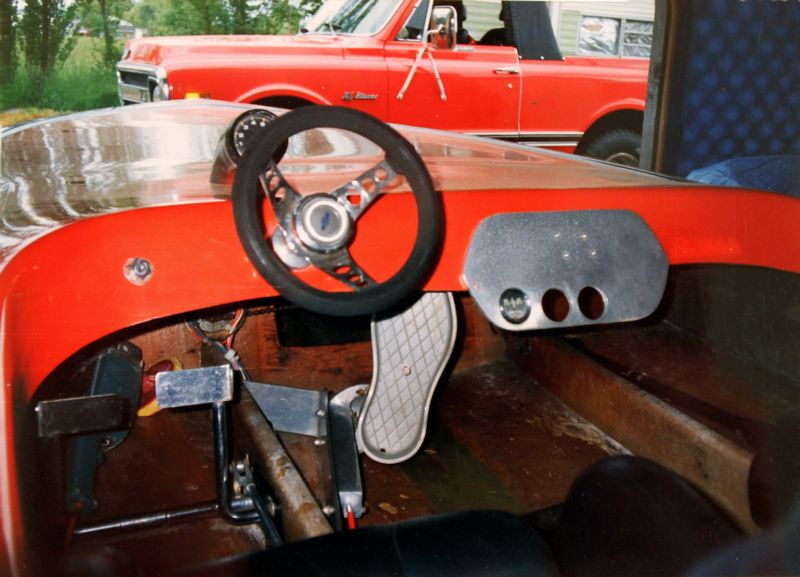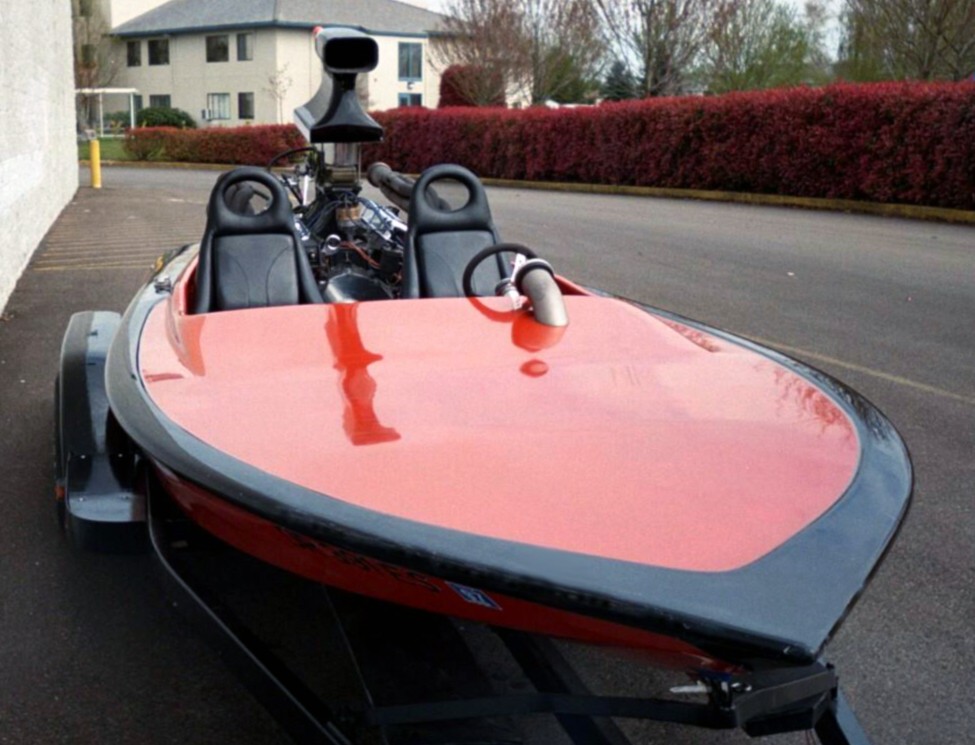111 mph is Incredibly fast on the water.
And the time it takes to get there is a
few seconds. Because this is a full race V-drive drag boat - there is no neutral, at least not like a normal boat. There's in-gear and out-of-gear and with my V-drive you could not put it into gear with the engine running. Normal protocol was to launch the boat then fire the engine up with the V-drive out-of-gear.
Then let the engine warm up for about 5 minutes. A Big Block Chevy is a LOT of CAST IRON and you need the block (as well as all the internals), to warm up before you do things like smash down the accelerator pedal. My engine builder, Tim Briggs told me with a high volume oil pump, (I ran a high volume, not a high pressure pump), if you accelerate when the oils is cold you could snap-off the tab on the oil pump or the slot on the oil pump shaft. For this reason, I always let the engine completely warm up before getting it on.
You have to know, this type of boat draws or sucks water out of the lake or river from a fitting on the underside of the hull. The water pump circulates the lake water through the engine and it exits out the side of the boat somewhere. This location varies depending on the brand, model and design. Most of the boats I've seen the water exits out the back. On my Sanger, there was 2 water outlets, one on each side of the boat. You can see the water flying out of the boat in this picture of me racing the boat.
So because the lake water in Oregon where I ran my boat was COLD and unlike a car where the water circulates in a closed system, you need to wait until the cast iron block gets good and warm before you take the boat out and start hammering on it because it takes a little longer to warm her up due to constant cold water circulating through the block.
Make sense?
What I would do is simply place my hand on the side of the block or hold onto the Indy Champ air scoop and walk to the back of the boat and feel the water coming out of the side of the boat. Not a big deal to wait when you're sitting in a title holding drag boat on a sunny day on the lake.

Also - this is interesting - because of the VOLUME of air being drawn down the Weiand Tunnel Ram with the dual 660 Holley Center Quitters - the sides of the tunnel ram would actually be really cold - almost iced over cold.
Here you can see the Tunnel Ram with the Holley Carbs and the Indy scoop.
Note the 4" stainless steel extensions between the top of the carbs and the base of the scoop?
Here's the sides of the intake or the tunnels - after blasting across the lake at over 100 miles per hour you could put your hand on this area and it would be freezing cold due the volume of air running through it.
When I bought the boat, it still had the original "barrel back" seats in it BUT the backs, where they bolt to the bottom of the seats, had been broken off and re-bolted on so many times and in so many places from the hard acceleration there was simply no good places to re-attach bolts. For this reason, I has the custom high-back bucket seats custom built. If you ever see a boat like mine anywhere, on the water or in pictures - LOOK at the seats. I've NEVER seen another race boat with high back bucket seats.
I has the seat builder install a custom piece of metal my buddy Eric whipped up to lock the backs to the bottoms so when I smashed down the accelerator pedal the backs of the seats couldn't simply break off.
Being a true race boat, my Sanger had 3 pedals.
- Accelerator Pedal
- Cavitation Plate UP Pedal
- Cavitation Plate DOWN Pedal
The Cavitation Plate is the flat sheet of aluminum you see on the back of the boat.
Here's context for the Cavitation Plate - you can also see the original low-back or Barrel Back seats.
The UP pedal pulls the cavitation plate upward and this means ZERO drag and nose up flying.
The DOWN pedal pushes the cavitation plate downward and creates drag and this pushes the nose of the boat down and also acts like a BRAKE, which slows the boat down.
When racing, the cavitation plate is in the up position and you only "feather" the down pedal if and when you feel the bow lifting too much. If you catch too much wind you will KITE the boat. And "yes", that's exactly what you think it is.
This is a kite flying in the wind...
This is okay - this is normal.
This is controlled flying.... At high speed, my Sanger would come out of the water like this all the time. You hold on, prepare for touching down and keep the pedal to floor.
This is bad, really bad. This is kiting a boat.
I kited my boat one time on Foster Reservoir. My boat came completely out of the water. like you see in the picture above but not completely straight up. I though I was going to flip over but after hanging in the air for what seemed like eternity - the boat plopped back down on the water.
The engine over revved when the prop came out of the water and spun 7 RODS. Needless to say - I had to row her back to the boat launch.
In the 20 years I ran this boat there was only one time I didn't take her over 100 miles per hour. So strong seats were a big deal.
Here's a good shot of them,
I can remember looking down at the floor and watching it flex up n down as I drove while my boss was next to the engine listening for any mis-fires.
The floor on my boat didn't flex but if you through her into a sharp corner at high speed - you bet - look back an the runners and the length of the boat hull would be twisting. The Sanger was designed with this in mind. No big deal. I monitored the hull for STRESS CRACKS every time I pulled her out of the water. None.
My buddy on the shore said we really didn’t have much boat in the water as we zoomed past him. Some things you never forget
Yeah - controlled flying or some would say a controlled accident.

My memory betrays me, but that is not the boat that took your leg, is it Mike?
Yes. When I was 26 years-old in 1986. It was a Saturday, July 31st, super hot day and we were down on the Willamette River in Albany, Oregon. I hated taking my boat to the river because you always have to fight the current. Not a big deal if you have a normal boat with a neutral and reverse. My boat had Go and No Go and in order to GO you had to turn the engine off, reach down between the back of the seats, turn the drive shaft over while putting just a tiny bit of pressure on the V-driver handle until you cold feel the gears mesh-up and the handle drop and then you're good to go. Fire up the engine an PUNCH IT.
I've thought about getting another Sanger Drag Boat but they're really only fun in clean, non-salt, fresh water and we don't have any of that here in South Florida.


























